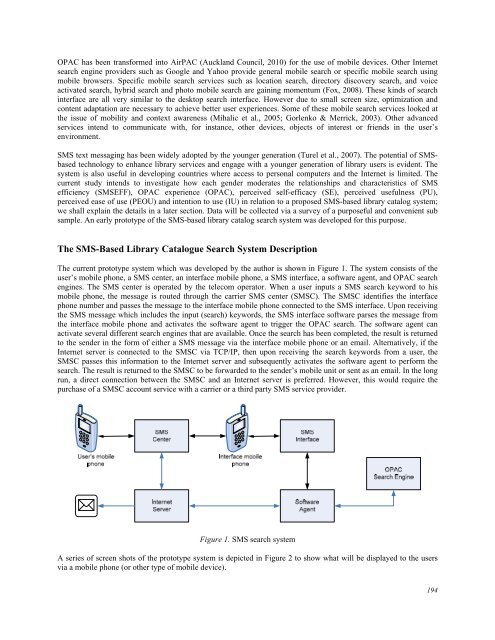October 2011 Volume 14 Number 4 - Educational Technology ...
October 2011 Volume 14 Number 4 - Educational Technology ...
October 2011 Volume 14 Number 4 - Educational Technology ...
Create successful ePaper yourself
Turn your PDF publications into a flip-book with our unique Google optimized e-Paper software.
OPAC has been transformed into AirPAC (Auckland Council, 2010) for the use of mobile devices. Other Internet<br />
search engine providers such as Google and Yahoo provide general mobile search or specific mobile search using<br />
mobile browsers. Specific mobile search services such as location search, directory discovery search, and voice<br />
activated search, hybrid search and photo mobile search are gaining momentum (Fox, 2008). These kinds of search<br />
interface are all very similar to the desktop search interface. However due to small screen size, optimization and<br />
content adaptation are necessary to achieve better user experiences. Some of these mobile search services looked at<br />
the issue of mobility and context awareness (Mihalic et al., 2005; Gorlenko & Merrick, 2003). Other advanced<br />
services intend to communicate with, for instance, other devices, objects of interest or friends in the user’s<br />
environment.<br />
SMS text messaging has been widely adopted by the younger generation (Turel et al., 2007). The potential of SMSbased<br />
technology to enhance library services and engage with a younger generation of library users is evident. The<br />
system is also useful in developing countries where access to personal computers and the Internet is limited. The<br />
current study intends to investigate how each gender moderates the relationships and characteristics of SMS<br />
efficiency (SMSEFF), OPAC experience (OPAC), perceived self-efficacy (SE), perceived usefulness (PU),<br />
perceived ease of use (PEOU) and intention to use (IU) in relation to a proposed SMS-based library catalog system;<br />
we shall explain the details in a later section. Data will be collected via a survey of a purposeful and convenient sub<br />
sample. An early prototype of the SMS-based library catalog search system was developed for this purpose.<br />
The SMS-Based Library Catalogue Search System Description<br />
The current prototype system which was developed by the author is shown in Figure 1. The system consists of the<br />
user’s mobile phone, a SMS center, an interface mobile phone, a SMS interface, a software agent, and OPAC search<br />
engines. The SMS center is operated by the telecom operator. When a user inputs a SMS search keyword to his<br />
mobile phone, the message is routed through the carrier SMS center (SMSC). The SMSC identifies the interface<br />
phone number and passes the message to the interface mobile phone connected to the SMS interface. Upon receiving<br />
the SMS message which includes the input (search) keywords, the SMS interface software parses the message from<br />
the interface mobile phone and activates the software agent to trigger the OPAC search. The software agent can<br />
activate several different search engines that are available. Once the search has been completed, the result is returned<br />
to the sender in the form of either a SMS message via the interface mobile phone or an email. Alternatively, if the<br />
Internet server is connected to the SMSC via TCP/IP, then upon receiving the search keywords from a user, the<br />
SMSC passes this information to the Internet server and subsequently activates the software agent to perform the<br />
search. The result is returned to the SMSC to be forwarded to the sender’s mobile unit or sent as an email. In the long<br />
run, a direct connection between the SMSC and an Internet server is preferred. However, this would require the<br />
purchase of a SMSC account service with a carrier or a third party SMS service provider.<br />
Figure 1. SMS search system<br />
A series of screen shots of the prototype system is depicted in Figure 2 to show what will be displayed to the users<br />
via a mobile phone (or other type of mobile device).<br />
194

















